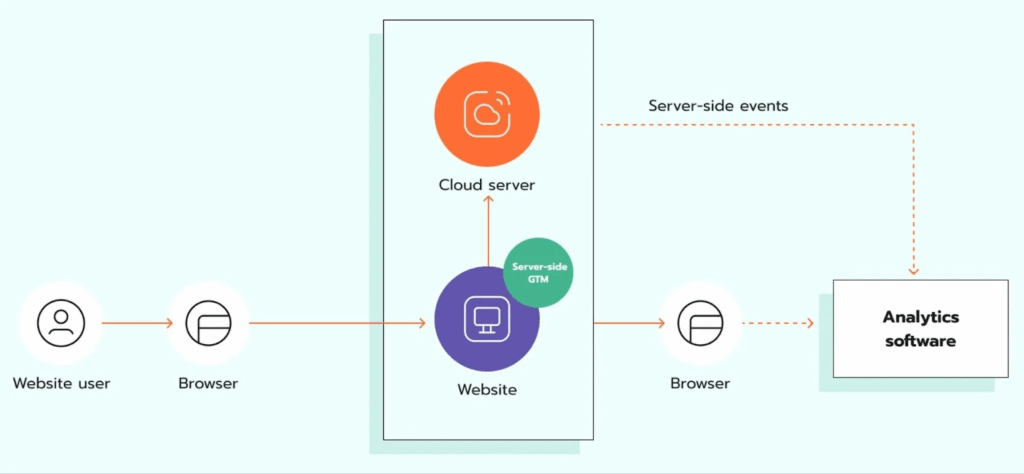Client-side tracking is a common data monitoring method where the user’s browser interacts directly with third-party services. However, this type of tracking is becoming less reliable in terms of data accuracy and compliance with privacy regulations. This is primarily due to several issues: the rise of ad-blockers, security vulnerabilities, the limited lifetime of third-party cookies, and data leaks.
Server-side tracking is emerging as a more effective solution. Introduced in 2020, it gained popularity over the past years due to higher transparency and the ability to address these problems.
How data loss and privacy regulations affect the performance of marketing campaigns
Browser restrictions, such as ITP in Safari, ad blockers, and privacy regulations, can result in a significant loss of data when running marketing campaigns. In the long run, it can have such consequences:
- Worse targeting and personalization. Highly personalized ad campaigns are becoming more challenging with restricted access to data on user behaviour and interactions with your website.
- Less precise conversion attribution. The restrictions on data tracking affect the accurate measurement of campaign performance and conversion attribution across different channels. Missing attribution data often leads to unassigned traffic in Google Analytics 4.
- Inefficient campaign optimization. Inaccurate data prevents marketing platforms from optimizing ad campaigns effectively. It results in a decrease in key marketing metrics such as return on ad spend (ROAS) and conversion rates (CR).
- Insufficient marketing budget management. Business owners may waste a lot of money on campaigns that don’t bring the expected results, and the lack of reliable data makes it harder to spot such campaigns and optimize them.
Why server-side tracking is a game-changer for agencies
To improve data quality and comply with privacy regulations, agencies use server-side tracking. Server-side tracking allows collecting data (user interactions or website events) directly from the user’s device to the server. This tracking method eliminates the need to rely on third-party services, offering more control over the data.
User data is gathered once consent is granted. Data from the website is transmitted to a cloud server, which then forwards it to third-party vendors and analytics platforms. The server acts as an intermediary, serving as a proxy between the website (or other data sources) and external tracking tools.

How server-side tracking works
Server-side tracking provides agencies with accurate information about user behavior. In this way, Farmasave, with the help of Tag Manager Italia, could reduce the gap between backend data and Google Analytics 4, cutting the discrepancy from 20% to just 6%. This improvement raised the accuracy of the data displayed and analyzed in GA4 to 94%.
Agencies can improve campaign cost-efficiency by using server-side tracking. For instance, this tracking method implementation helped increase the conversion rate of Decathlon Italia’s Facebook Ads campaigns while lowering the cost per click.
Consent management configuration on the server side allows tracking user consent more effectively. For example, by optimizing the layout of the cookie banner and configuring server-side tracking, MecShopping was able to double user consent rates from 24% to 50%.
Server-side tracking implementation path
Implementing server-side tracking includes the following steps:
- Choose a tag management system. The most versatile and popular is Google Tag Manager (GTM). It provides a wide range of tags, clients, and variables for the server GTM container, making it easier to implement server-side tracking for third-party platforms. With GTM, you get full control over your data.
- Decide on a hosting platform for a server GTM container. There are a few options. The first platform that comes to mind for GTM users is Google Cloud Platform (GCP). However, the hosting price on platforms like GCP is higher compared to third-party platforms like Stape. In addition, this hosting platform offers other benefits, such as a Demo account to pitch clients, an Agency account to manage clients’ containers in one place, or built-in Analytics to measure the impact of server-side tracking setup.
- Configure server-side tracking for the required platform. The configuration process will depend on the platforms your client uses (Meta, Google Ads, GA4, TikTok, etc.). Setting up tracking via a server GTM container requires more effort, but gives full flexibility. You’ll need to create a server container, configure clients and tags, and set up the connection to the web container. For agencies, this type of setup is ideal when you want to standardize tracking across multiple clients or build custom logic tailored to specific use cases. To get the most out of server-side tracking, it’s important to also add a protection layer for tracking scripts. For example, Stape provides additional features like Custom Loader (to increase resistance to ad blockers) and Cookie Keeper (to extend cookie lifetime in browsers like Safari). In combination with a custom tracking domain setup, you can improve data accuracy and conversion attribution for your clients.
- Set up a server-side consent management. That’s an essential step, as server-side tracking still requires asking for the user’s consent before data collection. One of the most popular server-side Consent Management Platforms is iubenda. It is an easy-to-use platform that prioritizes privacy in its approach to collecting and processing user data. In addition, it is a highly customizable solution, so you can create an appealing design while staying compliant with data regulations.
Conclusion
Data regulations such as GDPR and CCPA, the rise of ad blockers, and browser restrictions on cookie lifetime change the way the data is collected. Server-side tracking is a solution that lets agencies track data accurately.
With the proper configuration, clients can get precise data and stay compliant with regulations. Explore how to configure server-side consent management using iubenda and GTM in Stape’s blog post and start benefiting from complete control over the data collection process.
